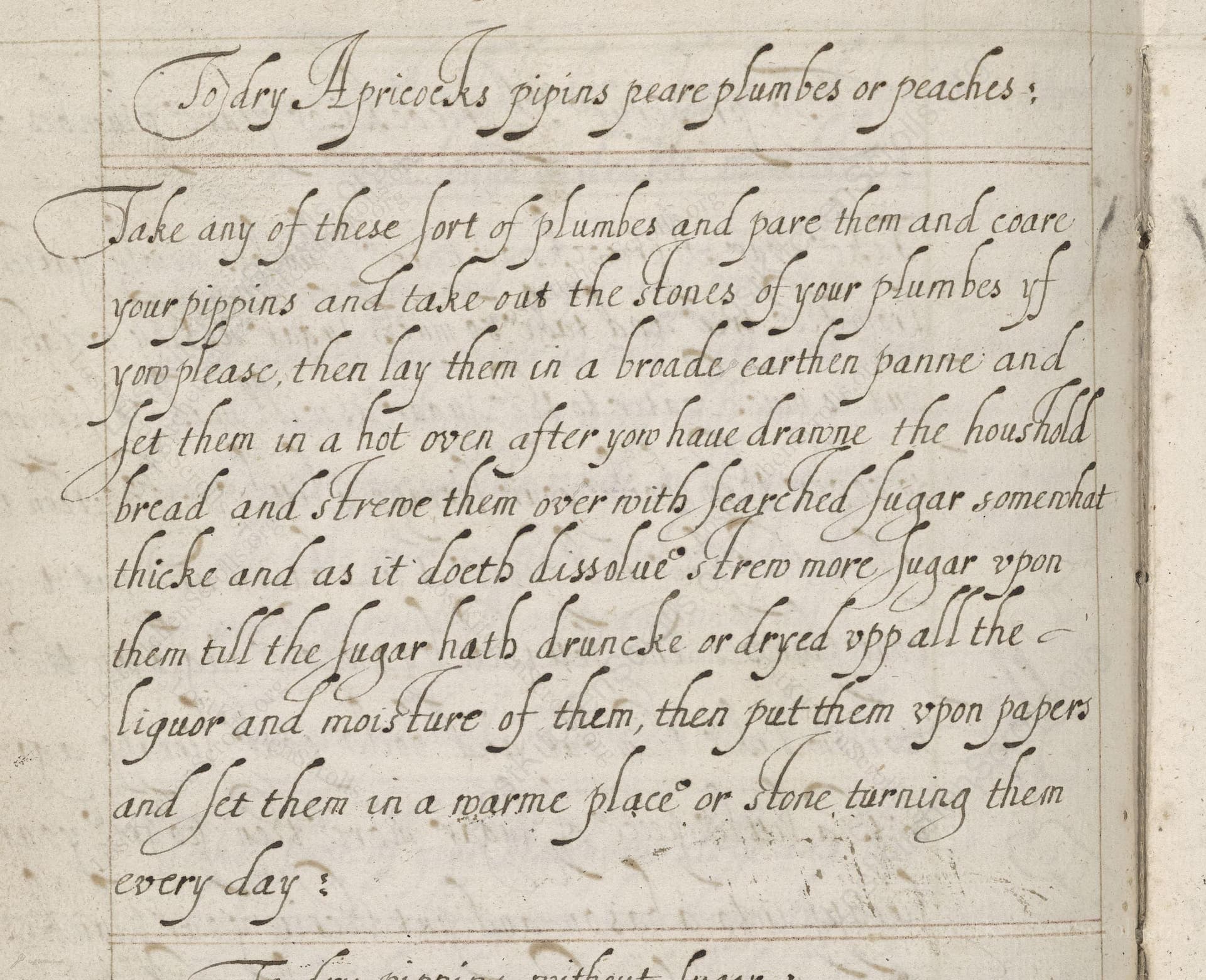To Dry Apricocks Pipins Peare Plumbes Or Peaches
From the treasured pages of Medicinal and cookery recipes by John King
Written by John King

To Dry Apricocks Pipins Peare Plumbes Or Peaches
"Take any of these sort of plumbes and pare them and coare your pippins and take out the stones of your plumbes yf you please, then lay them in a broade earthen panne and set them in a hot oven after you have drawne the houshold bread, and strewe them over with searched sugar somewhat thicke and as it doeth dissolve strew more sugar upon them till the sugar hath druncke or dryed upp all the liquor and moisture of them, then put them upon papers and set them in a warme place or stove turning them every day."
Note on the Original Text
Early modern English recipes lean heavily on assumed household knowledge, offering broad strokes and leaving much to the reader's judgment. Quantities and precise times are rare or absent—cooks were expected to know their ovens, ingredients, and preferences. Spellings varied: 'Apricocks' for apricots, 'searched sugar' for sieved sugar, 'druncke' for drunk (absorbed). The instructions are ordered but open-ended, prioritizing method and principle over rigid technique—a lovely invitation to culinary intuition.

Title
Medicinal and cookery recipes by John King (1675)
You can also click the book image above to peruse the original tome
Writer
John King
Era
1675
Publisher
Unknown
Background
A delightful journey into the kitchens of the 17th and early 18th centuries, this collection, attributed to John King, brims with time-honored recipes, culinary wisdom, and flavors that once graced historic tables.
Kindly made available by
Folger Shakespeare Library
This recipe comes from the early modern English period, spanning approximately 1625 to 1725. It was a time before modern canning and refrigeration, so drying fruits was a vital way to preserve excess orchard bounty for the winter months. The attribution to John King situates it among household manuscripts—collections of practical wisdom and family recipes. Baking ovens, fueled by wood or coal, were central to home life, and often retained heat after baking bread. Housewives cleverly used this residual warmth for gentle drying or slow cooking. Sugar, increasingly available but still precious, was applied both as a preservative and a luxury.

The cook would have used a broad earthenware or ceramic pan to hold the fruit, a household bread oven (a brick, wood-fired oven, cooling down after bread-baking), and perhaps a sieve or muslin to 'searche' the sugar (pass it through to make it fine). Papers for drying referred to sheets of parchment or even thick writing paper. Turning the fruit would be done by hand, sometimes with wooden tongs or spoons. A warm place or stove might have been the oven's residual heat, a hearth, or even a sunny windowsill—places less precise than our modern temperature-controlled appliances.
Prep Time
20 mins
Cook Time
1 hr 30 mins
Servings
4
We've done our best to adapt this historical recipe for modern kitchens, but some details may still need refinement. We warmly welcome feedback from fellow cooks and culinary historians — your insights support the entire community!
Ingredients
- 1 lb 2 oz fresh apricots, plums, peaches, pears, or apples (pippins)
- 7–10 oz white caster sugar (as needed to thoroughly coat and absorb juices)
- baking parchment or greaseproof paper
Instructions
- To make dried fruits such as apricots, apples (pippins), pears, plums, or peaches, begin by peeling the fruits and, for apples and pears, removing the cores.
- Take out the plum or peach stones as well, if you wish.
- Lay the prepared fruit in a large, shallow, oven-safe earthenware or ceramic dish.
- Place it in an oven that has just finished baking bread, so the oven is hot but not at its highest temperature (about 250–265°F).
- Generously sprinkle sieved white sugar over the fruits.
- As the sugar melts into their juices, continue sprinkling more sugar every so often, so that the sugar keeps absorbing any released moisture.
- Once no more liquid seeps out and the fruit looks glazed and almost dry, transfer the pieces onto baking parchment.
- Move them to a warm, dry spot or a food dehydrator or a very low oven (120–140°F), turning them daily, until fully dried and leathery.
- Store in an airtight container.
Estimated Calories
160 per serving
Cooking Estimates
Preparing and peeling the fruit takes about 20 minutes. The fruit then bakes for 1 to 1.5 hours to release moisture. After that, drying takes 8 to 12 hours, depending on the method you use and how juicy the fruit is. This recipe makes about 4 servings, with each serving having roughly 160 calories, assuming you use 250 g sugar and 500 g fruit.
As noted above, we have made our best effort to translate and adapt this historical recipe for modern kitchens, taking into account ingredients nowadays, cooking techniques, measurements, and so on. However, historical recipes often contain assumptions that require interpretation.
We'd love for anyone to help improve these adaptations. Community contributions are highly welcome. If you have suggestions, corrections, or cooking tips based on your experience with this recipe, please share them below.
Join the Discussion
Rate This Recipe
Dietary Preference
Main Ingredients

Den Bockfisch In Einer Fleisch Suppen Zu Kochen
This recipe hails from a German manuscript cookbook compiled in 1696, a time whe...

Die Grieß Nudlen Zumachen
This recipe comes from a rather mysterious manuscript cookbook, penned anonymous...

Ein Boudain
This recipe comes from an anonymous German-language manuscript cookbook from 169...

Ein Gesaltzen Citroni
This recipe, dating from 1696, comes from an extensive anonymous German cookbook...
Browse our complete collection of time-honored recipes



